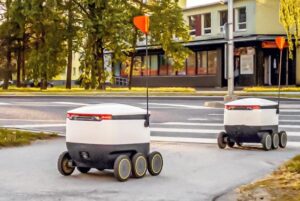Sidewalks are going to get very crowded, and now is the time to start thinking about what to do about it.
We all know that self-driving cars soon will become a common sight, but a white paper, “The Last Block,” by Canadian Bern Grush, an occasional contributor to Bacon’s Rebellion several years ago, contends that small robotic vehicles — delivering food and packages, sweeping, removing snow, measuring, monitoring, surveilling, repositioning dockless scooters — will precede them.
Dozens of companies from Amazon and FedEd to Starship and Uber, are building small sidewalk-bound robots to deliver food and parcels over the “last mile.” The arrival of these vehicles will require a significant re-thinking of the function and design of streets, sidewalks, and parking.
Virginia is not ready to accommodate a swarm of delivery bots. But there is still tie to get prepared.
Writes Grush:
The 21st century has brought many changes to the urban space between traffic lanes and buildings. The prior century — the century of the automobile — had relegated much of this space to storing cars for owners as they lived, worked, shopped, or visited. Some would be reserved for loading zones and the occasional bus stop. Nearer to buildings, the remaining space would be for pedestrians, and even this space was interrupted by driveways, fire hydrants, bus shelters, and sometimes a tree, a place to set, or a post to lock a bike.
This pattern is giving way to an even greater multiplicity of uses, including ride-hail pick-up and drop-office, ecommerce delivery, protected bicycle lanes, e-bikes, micro-transportation docks, and even al fresco dining. (Speaking of al fresco dining, I read elsewhere recently that the encroachment of restaurants upon sidewalks is creating problems for handicapped people in wheelchairs!)
These new uses, contends Grush, are not transient. Indeed, pressure on sidewalks could well increase as motors shrink, batteries last longer, and entrepreneurs innovate new forms of transport and introduce new services.
The widespread commercial deployment of driverless vehicles still awaits the resolution of safety legal liability issues. Although the regulatory and political barriers for delivery bots are much lower, Grush says, they are not insignificant. Delivery bots will have to navigate increasingly crowded sidewalks, running “a gauntlet of human legs, barking dogs, baby strollers, planter boxes, and uneven pavement — a much more disorderly environment than the highly regulated city streets where robotaxis will operate.”
Economics will drive the ubiquity of delivery bots. Writes Grush:
Any technology that lowers local delivery costs could help restore the fortunes of local businesses and begin to heal the economic harm merchants have endured from the coronavirus pandemic. According to FedEx, this is because “[on] average. more than 60% of merchants’ customers live within 4 km of a store location … demonstrating the opportunity for on-demand, hyper-local delivery.” In the scenario FedEx is describing, an on-demand service would move goods and food directly from merchants to customers using small robotic machines, with the local merchant acting as warehouse.
Last-mile delivery costs could be driven as low as a dollar.
As delivery bots begin crowding sidewalks, the competition for space and passage in these public spaces will increase. Much of the history of urban planning has revolved around resolving the conflicting rights and prerogatives of private vehicles, transit vehicles, goods delivery, bikes, and pedestrians. More parking or more bike lanes? More loading zones? Dedicated lanes for buses? Better protections for pedestrians. Sidewalks, parking lanes, and street lanes can be reconfigured, but only at considerable expense.
In early 2020, the International Organization for Standardization (ISO) launched an intelligent transport systems project to work out new operating guidelines.
“These machines will need to be prioritized, scheduled, queued, bumped, and placed in holding patterns regardless of nearby human oversight, and all without blocking crosswalks, bicycle lanes, micromobility users, no-stopping areas, or transit stops,” writes Grush. “This must be done safely, mixed with human-operated vehicles, without inconveniencing active transportation or pedestrian traffic, and with regard for human accessibility challenges.”
Grush proposes eight principles for operating principles for robots on sidewalks. Rule One: Robots must grant rights-of-way to humans in close proximity — but rules of engagement must consider how to prevent a robot from being immobilized for extended times in crowded circumstances. Read his white paper for more.
The bots are coming. Will Virginia be ready for them? Or will we succumb to chaos in the sidewalks?


Leave a Reply
You must be logged in to post a comment.